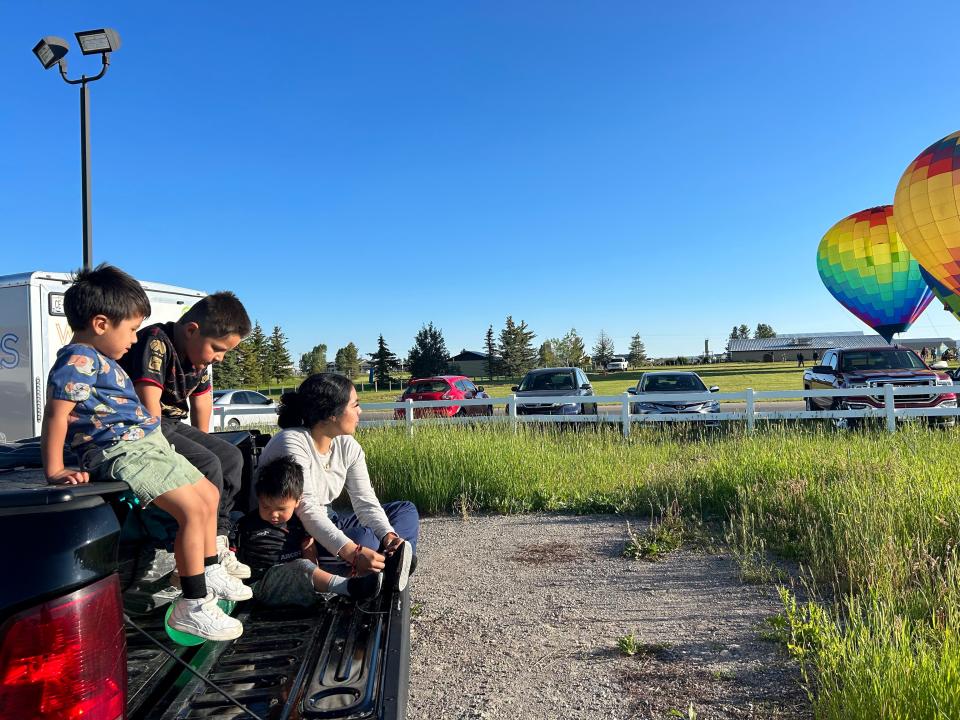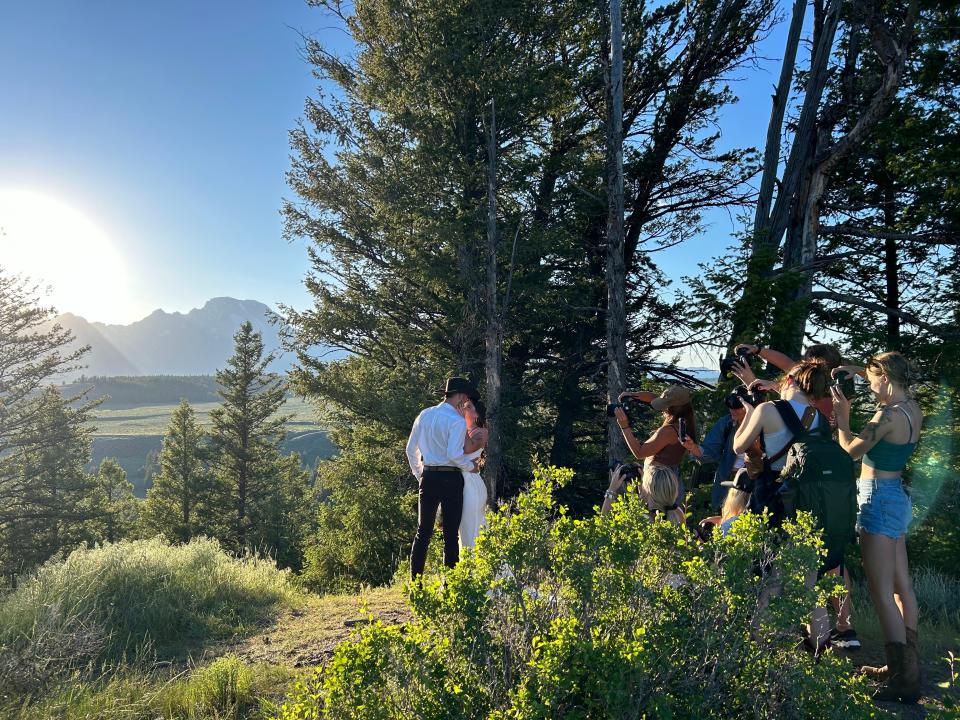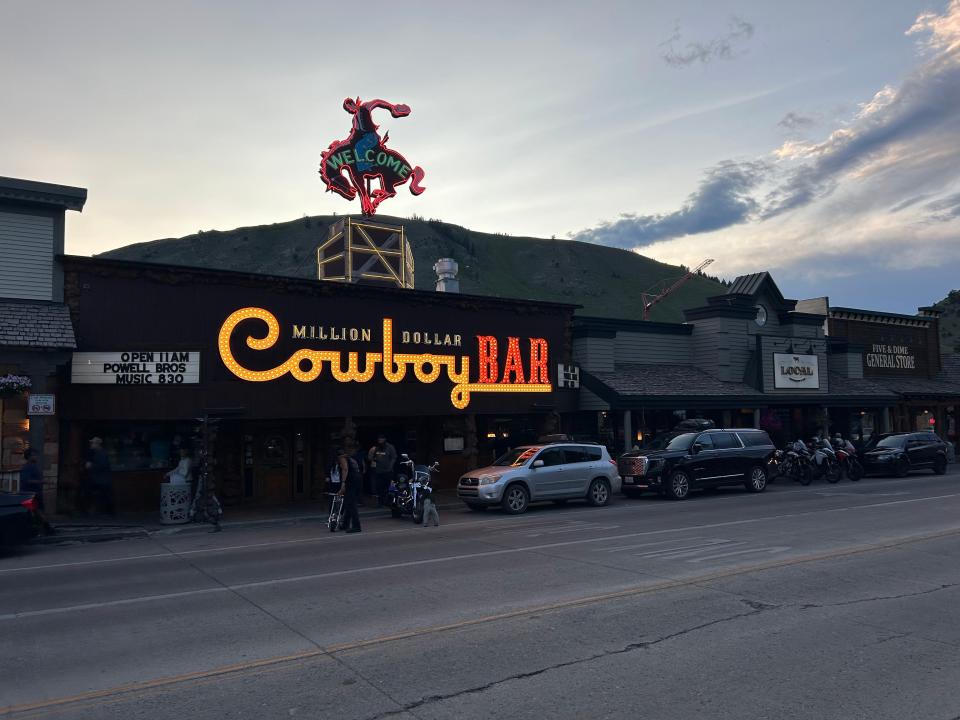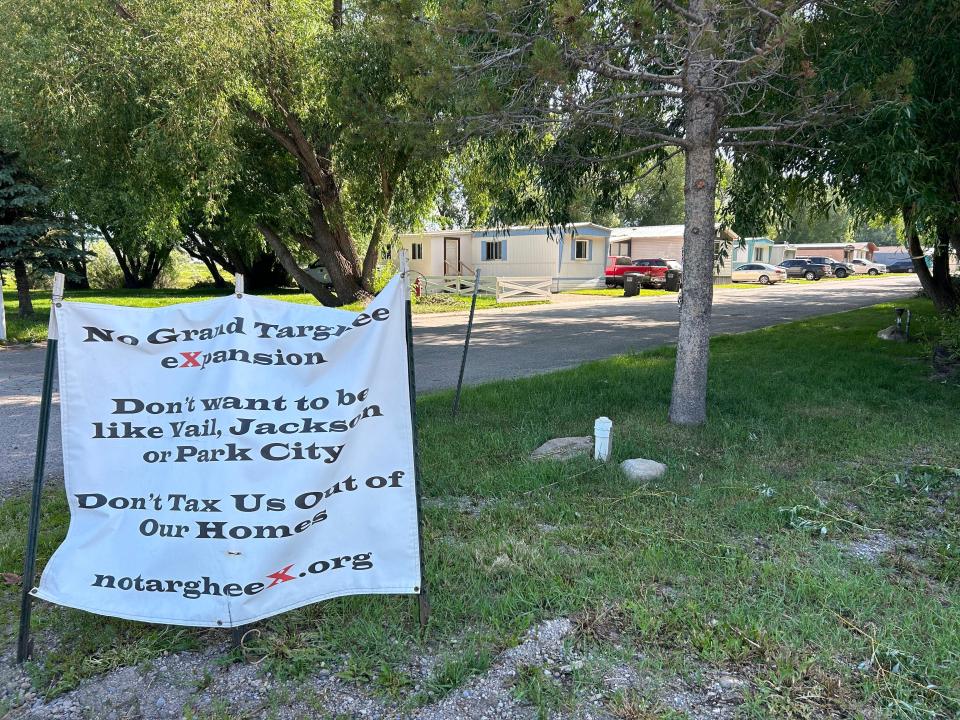Some parts of rural America are changing fast. Can higher education keep up?
DRIGGS, Idaho – It’s barely 6 a.m., and Alexis Luna is spending her one day off at the Teton Valley balloon festival, babysitting her three nephews so her sister won’t have to pay for day care. “I want to go up!” one of them shouts, scrambling over the bed of her black pickup truck.
They are watching the hot air balloons rise from the parking lot of the Super 8 here, where Luna spends her weekends working the front desk. Most weekdays, she commutes an hour to work at the Target in Jackson Hole, Wyoming, taking the bus lately because her truck has started breaking down from the winding, mountainous drive across the Teton Pass.
It’s a cross-state journey many choose to make from Teton County, Idaho, to Teton County, Wyoming, a place so prosperous that one sociologist has dubbed it “Billionaire wilderness.”

The average per-capita income on the Wyoming side is now $318,297 – no other county in America even eclipses $200,000 – compared with $34,714 on the Idaho side. Within Wyoming, though, there is a deep divide, too. The Wyoming average is skewed by the number of millionaires and billionaires moving to the region. The median per-capita income is much lower, around $55,000, and home prices have shot up to more than twice the state average in Wyoming. That makes America’s wealthiest county also one of its most unequal.
Across rural America, both income inequality and a lack of affordable housing are on the rise. Remote communities like the Tetons are facing not just an economic challenge, but also an educational one, as changing workforce needs meet a critical skills and training gap.
It’s created a strange dichotomy: Employers, particularly in the trades, say they need talent more than ever. Yet many workers report having trouble finding jobs that pay enough to cover their rapidly rising bills. And these trends have only become more pronounced since the pandemic, fueled in part by remote white-collar workers and others who brought with them an increase in housing demand without an increase in the local expertise to address it.
Education experts and state leaders who have long worried about that widening skill gap are now even more alarmed by the disparities exacerbated in an economy beset by inflation. The threat is existential in some rural communities, with few companies willing to move to regions without the workforces to support them, which is why more states have started directly tying academic programming to in-demand careers.
About that worker shortage: It was supposed to give people with no college degree opportunity. But has it?
Colleges rethinking how to serve rural students
Earlier this month, Montana announced that 12 of its colleges would establish more than a dozen “micro-pathways” – stackable credential programs that can be completed in less than a year – to put people on a path to either earning an associate degree or immediately getting hired in industries such as health, construction, manufacturing and agriculture.
“Despite unemployment hitting record lows in Montana, rural communities continue to struggle economically, and many low-income families lack the time and resources to invest in full-time education and training,” the Montana University System announced in a statement with its partner on the project, the national nonprofit Education Design Lab.
That same week, Wyoming held a “student-centered learning” kick-off event focused on developing educational programs that are more responsive to residents’ needs. In July, Kansas announced it was expanding its grant for apprenticeship programs.
The Legislature here in Idaho created an $80 million annual fund in April to give high school graduates up to $8,000 to attend community college or receive workforce training. The program, called Idaho Launch, promotes in-demand careers in fields such as agriculture, construction, healthcare and transportation. Similarly, the College of Eastern Idaho, which serves Teton County and surrounding communities, has started offering construction clinics in rural areas, hoping to expose more high-school students to the trades.
It’s part of a broader strategy to better serve rural students and understand what they really need. “Instead of telling people what we’re going to do for them, we’re asking people what they would like,” said Lori Barber, the college’s vice president of academic and student affairs.

When college officials heard over and over again, for example, about the lack of affordable contractors, they held a two-day construction workshop to expose potential students to working electricians, roofers and plumbers.
Some of the college’s first surveys were conducted at the local farmer’s market, but officials later realized that anyone who could afford to be buying fresh veggies at 2 p.m. on a Thursday probably wasn’t their target demographic. They shifted to handing out gift cards at the Broulim's grocery store, a popular lunch haunt for construction and service workers in the Driggs area.
One of the early results from that community engagement: The college enrolled its largest cohort of students in its English as a Second Language program in Driggs for the fall 2023 semester.
“There is no magic thing: You just keep going back, and listening, and showing up,” said Leslie Daugherty, head of design programs at the Education Design Lab, which worked with the college to conduct its research and suggest solutions.
But even the act of “showing up” is complicated by a post-pandemic landscape that has forced rural community colleges to use their limited resources to cover ever-expanding regions of need.
One takeaway from those grocery store interviews was that the college needed to expand its programs at its satellite office in Driggs. While it originally had plans to grow that campus, the college recently had to give that site up altogether because its lease became too expensive.
Barber said the college will still expand its GED, ESL and early college classes both online and in-person at the high school library in Driggs, even if they no longer have their own building. “If there is future demand for credit classes, we’ll consider adding them,” Barber said.
The making of a ghost town: When higher education fled this place.
More work, and more expenses
The challenge of rising costs and the lack of qualified workers seem omnipresent in the Tetons, from the barista who has struggled for months to find a contractor to install internet cables to the former chamber of commerce president who can’t believe how much things have changed since the days when locals used to quip, “You can’t eat the scenery.”
There is more work now, but there are also much higher expenses, said Ira Koplow, who started the Chamber of Commerce in Teton County, Idaho, decades ago. “It used to be that you had great views, but no way to pay the bills. Now, I refer to it as the 3-or-3 rule: You can only afford to live here if you have three jobs or three houses.”
For those on the Idaho side of the Tetons, it feels as if their county has become “the working class for Jackson,” said 32-year-old Blake Funston, who works two jobs in Wyoming. One is at a mountain biking resort in Alta. The other is at a bike shop not far from the main strip in Jackson, where wealthy patrons sip beers while straddling saddles at a bar called The Million Dollar Cowboy.

The growing divide between the ultra-wealthy of Jackson and the working class of Driggs has underscored the challenge states and schools face as they target rural residents for reskilling: How do you persuade people who need to pay bills today that they should start taking courses that might help them make more tomorrow?
Justin Sarbaum, a retired 43-year-old Army infantryman from eastern Idaho, thinks a renewed focus on the trades would be good for the next generation, including his own three kids.
“My oldest boy, bless his heart, he wants to do everything, and it’s a different thing every single day. He says he wants to be a YouTuber,” Sarbaum said.
“Jobs like electricians, concrete, all the trades of the world … that’s what’s going to keep society going. You will forever need someone to work on your car, forever need a roofer. You want to go get a cool job? Go be a heavy machinery operator.”
No time for dreaming
However, finding time and money to learn a new trade is a very real predicament for potential students like Luna, who doesn’t feel like going back to school is a legitimate option after graduating from Teton High School and into a pandemic.
She originally moved to Idaho to live with relatives a decade ago, but she and her uncle have borne most of the financial burden since her aunt died unexpectedly from carbon monoxide poisoning while cleaning a mansion in Wyoming.
“I am tired a lot,” said the 20-year-old, who has been working various jobs since eighth grade.

For a time, Luna dreamed of going to cosmetology school. Then she could work at a salon, doing the face masks and other lux cleansing rituals people in Jackson are willing to pay so much more money for than in Driggs.
Now those plans seem far off. She has to make payments on the truck and to fix its transmission. She has to pay her share of rent on the mobile home she shares with her uncle and her grandma, who is now 82 and needs just as much help as ever.
Her life doesn’t leave much space for dreaming big or looking much far ahead at all. Despite watching those balloons float over the Grand Tetons for each of the past five years, she has never been into the Wyoming national park herself.
She would like to, someday.
Nick Fouriezos is a staff reporter for Open Campus, a nonprofit newsroom focused on higher education, where he covers colleges’ role in rural America. Read this story on the Open Campus website.
This article originally appeared on USA TODAY: Rural America's workforce needs have put higher education on notice

